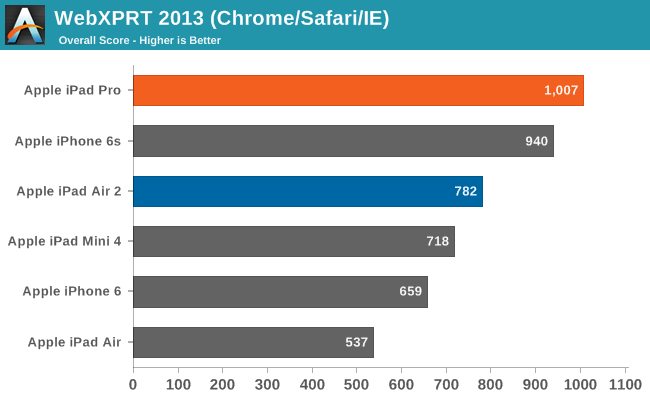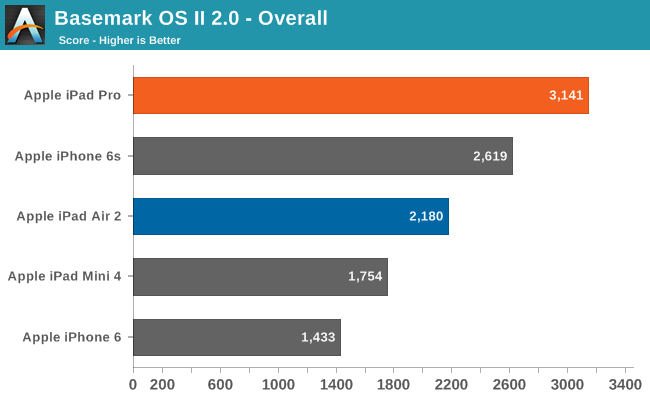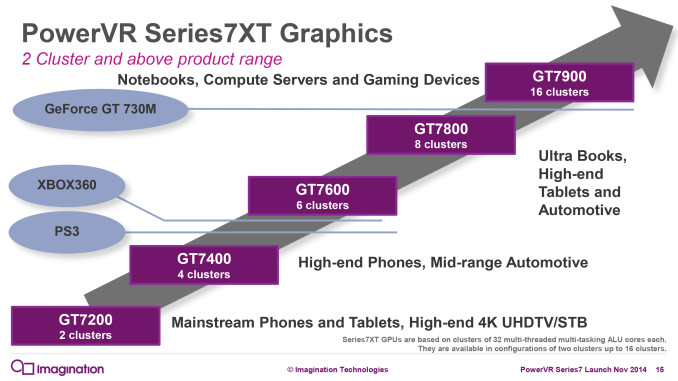The iPad Pro Preview: Taking Notes With iPad Pro
by Joshua Ho & Ryan Smith on November 11, 2015 7:00 AM ESTThe A9X SoC & More To Come
Finally, as everyone is undoubtedly eagerly anticipating our look at the A9X SoC inside the iPad Pro, let’s take a very quick look at what we know about the SoC so far. There’s a bit of a limit to what we can do blindly via just software, but I’m hoping that the eventual A9X die shots will confirm some of our suspicions on A9X’s configuration.
| Apple SoC Comparison | ||||||
| A9X | A9 | A8X | A6X | |||
| CPU | 2x Twister | 2x Twister | 3x Typhoon | 2x Swift | ||
| CPU Clockspeed | 2.26GHz | 1.85GHz | 1.5GHz | 1.3GHz | ||
| GPU | PVR 10 cluster Series7? | PVR GT7600 | Apple/PVR GXA6850 | PVR SGX554 MP4 | ||
| RAM | 4GB LPDDR4 | 2GB LPDDR4 | 2GB LPDDR3 | 1GB LPDDR2 | ||
| Memory Bus Width | 128-bit | 64-bit | 128-bit | 128-bit | ||
| Memory Bandwidth | 51.2GB/sec | 25.6GB/sec | 25.6GB/sec | 17.1GB/sec | ||
| L2 Cache | 3MB | 3MB | 2MB | 1MB | ||
| Manufacturing Process | Unknown (TSMC 16nm or Samsung 14nm) |
TSMC 16nm & Samsung 14nm |
TSMC 20nm | Samsung 32nm | ||
First and foremost, the most unexpected news here is that unlike A8X, A9X is not packing a triple-core CPU. Instead A9X drops back down to just a pair of Twister CPU cores. The twist here is that relative to A8X and A9, Apple has cranked up their CPU clockspeeds. Way, way up. Whereas the iPad Air 2 (A8X) shipped at 1.5GHz and the iPhone 6s (A9) at 1.85GHz, the A9X sees Apple push their clockspeed to 2.26GHz. Not counting the architectural changes, this is 22% higher clocked than the A9 and 51% higher than the A8X.
The fact that Apple dropped back down to 2 CPU cores is unexpected given that we don’t expect Apple to ever go backwards in such a fashion, and while we’ll never know the official reason for everything Apple does, in retrospect I’m starting to think that A8X was an anomaly and Apple didn’t really want a tri-core CPU in the first place. A8X came at a time where Apple was bound by TSMC’s 20nm process and couldn’t drive up their clockspeeds without vastly increasing power consumption, so a third core was a far more power effective option.


By comparison, with the FinFET process Apple is using here – and given the lower volume of A9X I don’t have reason to believe it’s dual-sourced, so it’s either TSMC or Samsung – Apple has been free to increase their clockspeeds substantially. At the same time these FinFET processes are still new and yields won’t be great, so there is a strong incentive to keep die sizes down to keep yields up, and adding a third core would only make that harder. If I had to guess, Apple only wanted two cores to begin with – this makes it easier for developers knowing that they only have two cores to work with – and that it’s A8X that is the anomaly.
Otherwise a highly clocked CPU is far more in-line with Apple’s design philosophy as it means that A9X is capable of amazing single-threaded performance – and keep in mind that we’re talking ARM Cortex-A57-like clockspeeds for a CPU that gets much more work done per cycle – so what we see here makes a lot of sense. Plus with iPad Pro in particular Apple has more battery capacity to sustain the power draw of a higher clocked SoC, and more surface area to dissipate that heat, so the usual concerns about power and cooling aren’t quite as pressing. I do wonder if this will impact multitasking performance much, but given what Twister is capable of, I’m not nearly ready to write off a dual-core Twister implementation clocked this high.
Moving on, as is customary for the X-series SoCs from Apple, A9X features what I believe to be a wider 128-bit LPDDR4 memory bus. The memory bandwidth numbers clearly point to a wider bus, and Apple needs the bandwidth to feed a more powerful GPU.
| Geekbench 3 Memory Bandwidth Comparison (1 thread) | ||||||
| Stream Copy | Stream Scale | Stream Add | Stream Triad | |||
| Apple A9X 2.26GHz | 20.8 GB/s | 15.0 GB/s | 15.3 GB/s | 15.1 GB/s | ||
| Apple A8X 1.5GHz | 14.2 GB/s | 7.44 GB/s | 7.54 GB/s | 7.49 GB/s | ||
| A9X Advantage | 46.4% | 101% | 103% | 102% | ||
Which brings us to the last bit of our preview, the GPU. Apple went with a 6 cluster PowerVR Series7 design on A9, and for A9X they have gone with a larger design. Without a die photo it’s basically impossible to determine how many clusters are in use since clockspeed plays such an important role. What we do know is that GPU performance relative to A9 has pretty much doubled, which once again is right in-line with Apple’s usual design goals.

Given what Apple has done with clockspeed on Twister, for the moment I am staking my bet on it being a 10 cluster design with a higher GPU clockspeed than A9 giving us the rest of the performance boost. To be clear here this could also be a 12 cluster design at a similar clockspeed or even an 8 cluster design clocked far higher – we’ll need die shots to confirm – but given all of the options it’s a 10 cluster design that is the best balance between die size and clockspeed, and it would also be the biggest curveball Apple could throw. It should also be noted that PowerVR Series7 certainly supports such a configuration since it’s scalable from 2 to 16 clusters, although in Imagination’s official product catalog they don’t have a name for such a configuration. So for the moment I’m simply calling it a 10 cluster Series7.
Anyhow, we’ll be back later with a full review of the iPad Pro, including the pros and cons of Apple’s first large-format, productivity-oriented tablet, and a full breakdown of the A9X SoC. So until then stay tuned.











199 Comments
View All Comments
blackcrayon - Friday, November 13, 2015 - link
Probably typed it on one of Samsung's Note devices.darkich - Saturday, November 14, 2015 - link
Lol, you got that right. :DBut seriously, I think it had to do with the browser used which had some issues with the word input within the reply window.
Besides, it's irrelevant to my point - a lack of handwriting recognition on such a device is beyond belief and a total insult to the user.
Gary323 - Friday, November 13, 2015 - link
Any ETA for the full review? I would really appreciate a side by side comparison of note taking in onenote (iPad Pro vs Surface Pro 4). I'm looking for the best stylus onenote experience. Thanks!simard57 - Friday, November 13, 2015 - link
What are your need for the OneNote experience?Do you require handwriting recognition?
Do you require searching the notes?
Gary323 - Saturday, November 14, 2015 - link
My needs would include handwriting recognition, with search functionality. I would also like to embed audio recordings and videos into my notes. As far as I can tell, both iOS and windows versions support this functionality (with the exception of embedding video in onenote on iOS - although this feature is coming according to microsoft). Are there other significant differences between the latest onenote for iOS and the onenote for Windows? If not, it seems like a decision should be made based on the best stylus experience.Link for the OCR and handwriting recognition in iOS onenote: https://blogs.office.com/2015/05/14/search-handwri...
Link for audio and video embedding on both platforms:
https://blogs.office.com/2015/11/12/onenote-in-nov...
sergiu - Friday, November 13, 2015 - link
From some other quick reviews it seems that A9X is quite powerful in per core. May I suggest trying some more unusual tests like a Skylake CPU against A9X in single thread scenarios?. This would imply finding some more tests other than the standard web ones that can run on both machines. It could be some Java benchmarks, Java based transcoders or C/C++ code that can be ported on both machines. Tests should be done with all optimizations possible on both systems and then results normalized per GHz. It would be an apple to oranges test, but it will show how efficient ARM can be these days compared with plain old x86.darkich - Friday, November 13, 2015 - link
Well if core frequency is a reliable measure, we can expect a Geekbench score of slightly over 3000 (!!)This thing has loads of raw compute power.
Now. Just imagine four of those cores clocked at 3GHz. More than enough raw CPU power even for the highest end MacBook Pro
darkich - Friday, November 13, 2015 - link
And of course, by 3000 I mean the single core performancetipoo - Tuesday, November 17, 2015 - link
Depending on if the pipeline is long enough to clock that high. As high IPC as Apple cores are I think it's probably short/optimized for lower clocks.blackcrayon - Thursday, November 19, 2015 - link
Going to be difficult getting Java code running on an iOS device, it's not supported by Apple in any way. There are JVMs for jailbroken devices but that obviously wouldn't be a good test for a number of reasons (not that you can JB an iPad Pro yet).There are at least some real world tests that could be done as well- there are some cross Mac OS X and iOS apps to make some comparisons. Microsoft Office, Pixelmator, iMovie... These would be tests of the OS & code as much as the CPU, but still of practical usefulness when wondering just how quickly an iPad Pro does something compared to a MacBook.